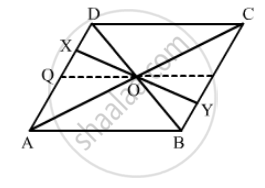Advertisements
Advertisements
प्रश्न
Diagonals of parallelogram ABCD intersect at O as shown in the following fegure. XY contains O, and X, Y are points on opposite sides of the parallelogram. Give reasons for each of the following:
(i) OB = OD
(ii) ∠OBY = ∠ODX
(iii) ∠BOY = ∠DOX
(iv) ∆BOY ≅ ∆DOX
Now, state if XY is bisected at O.

उत्तर
(i) Diagonals of a parallelogram bisect each other.
(ii) Alternate angles
(iii) Vertically opposite angles
(iv)\[\text{ In } ∆ BOY \text{ and } ∆ DOX: \]
\[OB = OD (\text{ diagonals of a parallelogram bisect each other })\]
\[\angle OBY = \angle ODX (alternate angles)\]
\[\angle BOY = \angle DOX (\text{ vertically opposite angles })\]
ASA congruence:
XO = YO (c.p.c.t)
So, XY is bisected at O.
APPEARS IN
संबंधित प्रश्न
Name the quadrilaterals whose diagonals are perpendicular bisectors of each other
All the angles of a quadrilateral are equal to each other. Find the measure of each. Is the quadrilateral a parallelogram? What special type of parallelogram is it?
Which of the following statement is true for a rhombus?
It has two pairs of parallel sides.
Which of the following statement is true for a rhombus?
It has only two pairs of equal sides.
Which of the following statement is true for a rhombus?
Two of its angles are at right angles
Which of the following statement is true for a rhombus?
It can be a square.
Fill in the blank, inthe following, so as to make the statement true:
A square is a rhombus in which .....
Construct a rhombus whose diagonals are of length 10 cm and 6 cm.
Which of the following statement is true for a rectangle?
Its diagonals are equal and bisect each other.
A rhombus is a parallelogram in which ______ sides are equal.
